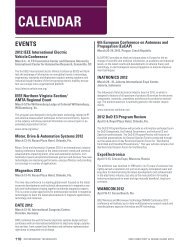2011 EMC Directory & Design Guide - Interference Technology
2011 EMC Directory & Design Guide - Interference Technology
2011 EMC Directory & Design Guide - Interference Technology
Create successful ePaper yourself
Turn your PDF publications into a flip-book with our unique Google optimized e-Paper software.
K e e bl e r, Berge r<br />
and identify new needs to replace older analog I&C equipment.<br />
For various reasons, some plants plan and request<br />
limited-scope surveys at the point-of-installation (POI).<br />
Surveys are carried out to gain additional knowledge regarding<br />
the EME prior to the upgrade and how the installation<br />
of the new equipment affected the EME. Of the surveys that<br />
EPRI has carried out between 2001 and 2010, unexpected<br />
knowledge regarding the EME was always learned after the<br />
survey. Utility customers reported after their review with<br />
the NRC regarding their digital upgrade projects that the<br />
initiative taken to do the survey and the information gained<br />
from doing it were positive steps in helping the plant, the<br />
NRC, and the NPP industry to understand more about<br />
<strong>EMC</strong> concerns and help achieve enhanced <strong>EMC</strong> for digital<br />
upgrade projects.<br />
Secondly, utility engineers engaged in the design of<br />
advanced NPPs have expressed the importance of having<br />
POI surveys carried out prior to actually constructing new<br />
advanced plants. One might ask, “How can this be done?” As<br />
part of the design process, a pre-operational demonstration<br />
is built for the digital I&C equipment planned for use in new<br />
plants. Survey activities can be carried out in these areas<br />
for each utility planning an advanced plant. Measurements<br />
to characterize the low-frequency radiated magnetic fields<br />
and low- and high-frequency radiated electric fields can<br />
be made. Conducted emissions measurements of low- and<br />
high-frequency can also be made. In fact, there is technical<br />
benefit to making these measurements in these areas away<br />
from the cluttered EMEs of advanced plants after they are<br />
built. Data from such measurements will be useful in the<br />
development of an emissions analysis database and can be<br />
used to compare to the emissions captured during <strong>EMC</strong><br />
certification of digital I&C equipment, emissions from analog<br />
I&C equipment, from historical surveys in existing plants,<br />
recent surveys in existing plants and emissions captured<br />
when advanced plants are completed as well as emissions<br />
captured during an EMI investigation.<br />
radiated emissions<br />
If requested as a part of the survey, conducted emissions<br />
could have been measured along power and data cables on<br />
the existing analog control system. This in situ study on a<br />
DCS is the first of its kind. Only the electric field emissions<br />
from 10 kHz to 6 GHz are reported in this paper.<br />
Once the DCS was set up for testing and training in the<br />
TTF facility, a second visit was made to the site. The same<br />
groups of measurements were made but with the DCS<br />
mounted only in wooden racks without any metallic system<br />
cabinets in place. (These measurements are not provided<br />
here.) After the DCS was installed and operational, the next<br />
visit was made to the site where emissions measurements<br />
(discussed in this paper) were again made in the control<br />
room at the same antenna positions. Measurements were<br />
also taken with selected system cabinet doors open for<br />
comparison but are also not included in this paper. A new<br />
automated emissions measurement system, developed by<br />
EPRI was used to capture the emissions data and is further<br />
described in Section III. B.<br />
MEASUREMENT METHODS FOR COLLECTING<br />
RADIATED EMISSIONS DATA<br />
The NRC NUREG 1.180 (Rev. 1) 2003 and the<br />
EPRI TR-102323 (Rev. 3) 2004 Documents<br />
The document, “<strong>Guide</strong>lines for Evaluating Electromagnetic<br />
ABOUT THE ORIGINAL SURVEY PROJECT FOR<br />
DCS UPGRADE<br />
As a part of the digital control system (DCS) upgrade program<br />
for Units 1 and 2, a major US nuclear power plant<br />
requested that a survey for radiated magnetic and electric<br />
fields be conducted in three areas: 1) Control Room – near<br />
the system cabinets in the control room where the existing<br />
analog control system is to be retrofitted with the new<br />
digital control system for Units 1 and 2, 2) the Operator<br />
Assist Computer (OAC) Computer Room area for Units 1<br />
and 2, and 3) the Testing and Training Facility (TTF) Facility<br />
where the DCS was set up for testing. A survey plan<br />
was designed to investigate the radiated EME in each areas.<br />
The investigation was carried out by conducting a partial<br />
<strong>EMC</strong> survey measuring the radiated emissions for Unit 1<br />
and 2 for electric fields from 10 kHz to 6 GHz and for magnetic<br />
fields from 20 Hz to 100 kHz with the analog control<br />
system in place and operational. A full <strong>EMC</strong> survey would<br />
entail measuring both radiated and conducted emissions.<br />
interferencetechnology.com interference technology 93


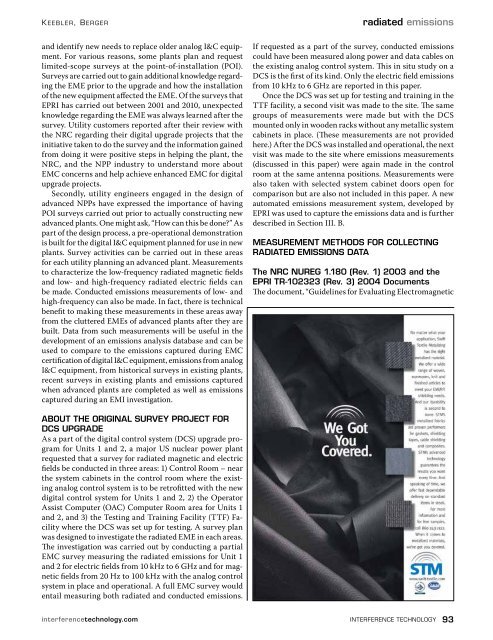

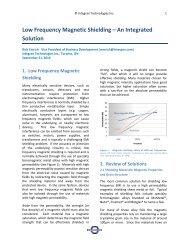

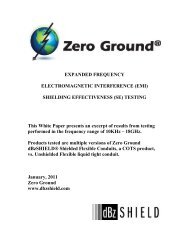
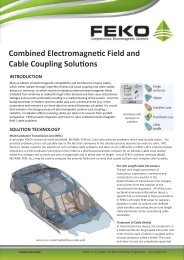



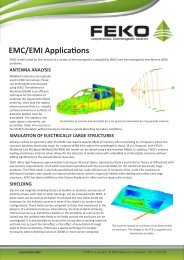
![[ thursday ] morning sessions 8:30 am-noon - Interference Technology](https://img.yumpu.com/23176841/1/190x247/-thursday-morning-sessions-830-am-noon-interference-technology.jpg?quality=85)
